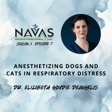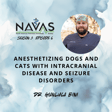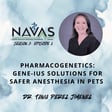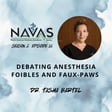
A Deep Dive into Fluid Therapy with Dr. Jane Quandt - Ep. 13
Water is life’s matter and matrix, and there is no life without it. Even the founding fathers of the US understood that water was essential to sustain life, with Benjamin Franklin being quoted as saying “When the well’s dry, we know the worth of water.”
Patients often present to veterinary hospitals with a dry well, and many of them may require diagnostics or surgery under sedation or anesthesia. You may have thought “I’ll give twice the fluid maintenance rate to this patient”, but where did this value come from? How do we empirically create an appropriate fluid therapy plan for anesthetized patients? Today’s guest on the NAVAS podcast, Dr. Jane Quandt, will guide our listeners through this very question.
Dr. Quandt is a long-time veterinary educator at the University of Georgia College of Veterinary Medicine and boarded in both Anesthesia and Emergency Medicine. With her expertise and unique perspective, we will cover a wide range of topics regarding fluid therapy in anesthetized patients, including using pulse oximeters to determine fluid responsiveness, how to use fluids to appropriately treat anesthesia-induced hypotension, when and should you use a colloid, how to use hypertonic fluids, and fluid resuscitating patients with elevated sodium values.
So, water-ver you do, be prepared to get your ears wet with this in-flow-mative conversation all about fluid therapy!
For more information on this episode’s topic, we invite our listeners to check out the 2013 AAHA/AAFP Fluid Therapy Guidelines for Dogs and Cats, specifically the section on Fluids and Anesthesia
If you like what you hear, we have a couple of favors to ask of you:
Become a member at North American Veterinary Anesthesia Society (NAVAS) for access to more anesthesia and analgesia educational and RACE-approved CE content.
Spread the word. Share our podcast and FB/IG posts, re-tweet, post something on a network or a discussion forum, or tell a friend over lunch. That would really help us achieve our mission: Reduce mortality and morbidity in veterinary patients undergoing sedation, anesthesia, and analgesia through high-quality, peer-reviewed education.
We also ask our listeners to save the date for the NAVAS Virtual Spring Symposium on April 27th and 28th, 2024. For more information about the program, visit the NAVAS Spring Symposium website. Several speakers will discuss blood pressure management under anesthesia, which will include fluid therapy. Registration starts Feb. 1.
Thank you to our sponsor, Dechra - learn more about the pharmaceutical products Dechra has to offer veterinary professionals, such as Zenalpha.
If you have questions about this episode or want to suggest topics for future episodes, reach out to the producers at education@mynavas.org.
All opinions stated by the host and their guests are theirs alone and do not represent the thoughts or opinions of any corporation, university, or other business or governmental entity.
The NAVAS Podcast is published monthly on or near the 15th of the month.
Special thanks to Chris Webster for editing, producer Maria Bridges, and Saul Jimenez for IT support in making this podcast a reality.











